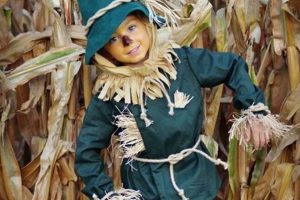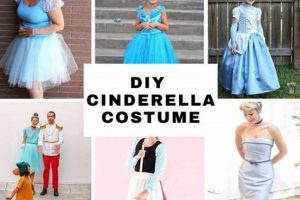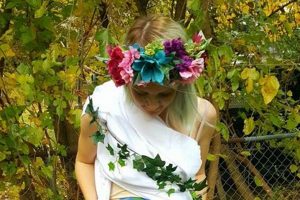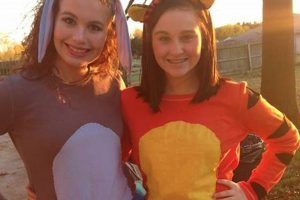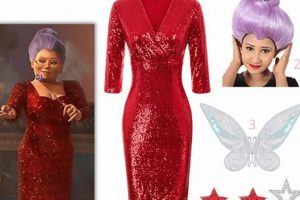The focus of this article is on the creation of homemade, unsettling doll-themed attire for costuming purposes. Such endeavors typically involve repurposing existing clothing, applying makeup to simulate doll-like features, and incorporating accessories to enhance the eerie aesthetic. An example includes a dress adorned with artificial cracks, coupled with pale makeup and exaggerated lashes to mimic a porcelain dolls appearance.
Constructing such a costume allows for personalized creative expression and cost-effectiveness when compared to purchasing pre-made alternatives. The appeal often lies in the ability to customize the level of creepiness, ranging from mildly unsettling to overtly horrifying. Historically, doll imagery has been utilized in various forms of media to evoke feelings of unease, making it a popular choice for Halloween and themed events.
The subsequent sections will delve into specific techniques for achieving a convincingly eerie doll-like visage through makeup application. Further discussion will explore clothing and accessory choices, providing guidance on crafting a complete and impactful visual representation. Furthermore, the topic will introduce different versions and types for the concept.
Tips for Crafting an Effective Creepy Doll DIY Costume
Achieving a convincingly unsettling doll costume requires meticulous attention to detail. The following tips offer guidance on key aspects of the creation process, ensuring a memorable and impactful result.
Tip 1: Emphasize Porcelain-Like Skin: A pale, matte complexion is crucial. Utilize white face paint or a foundation several shades lighter than the natural skin tone. Set with translucent powder to minimize shine and create a lifeless appearance.
Tip 2: Focus on the Eyes: Enlarge the eyes through strategic makeup application. White eyeliner on the lower waterline creates the illusion of larger eyes. Darken the upper lash line with a thick, winged eyeliner for dramatic effect. Consider using large, doll-like false eyelashes.
Tip 3: Exaggerate the Mouth: An unnaturally small or wide mouth contributes to the doll-like aesthetic. Red lipstick, applied carefully to reshape the lips, can achieve this effect. Consider drawing thin, exaggerated cracks around the mouth with a fine-tipped eyeliner for added creepiness.
Tip 4: Incorporate Cracks and Damage: Adding cracks to the face and body enhances the unsettling nature of the costume. Use a fine-tipped eyeliner or face paint to draw delicate lines simulating cracks in porcelain. Focus on areas prone to damage, such as around the eyes and mouth.
Tip 5: Select Appropriate Attire: Opt for vintage-inspired dresses or outfits reminiscent of antique dolls. Ruffled collars, lace details, and pastel colors contribute to the desired aesthetic. Deliberately damage or distress the clothing to further enhance the creepy factor. Stains, tears, and smudges add to the overall effect.
Tip 6: Hairstyle is Key: Hairstyle should complement the overall doll aesthetic. Pigtails, braids, or curled hair secured with ribbons or bows are appropriate choices. Tease the hair for a more disheveled and unsettling look.
Tip 7: Accessorize Thoughtfully: Accessories complete the transformation. Antique dolls, porcelain masks, or oversized keys contribute to the unsettling atmosphere. Carry a small, worn teddy bear or other childhood toy for added effect.
Careful consideration of these tips can significantly elevate the impact of the costume, creating a more authentic and unsettling portrayal of a creepy doll. The goal is to evoke a sense of unease and discomfort, drawing on the inherent creepiness associated with dolls.
The subsequent section will address variations on this theme, exploring different types of doll costumes and their unique characteristics.
1. Unsettling Makeup Application
Unsettling makeup application is a cornerstone in the successful creation of a disturbing doll-themed ensemble. It serves as a primary visual cue, immediately signaling the intended character and setting the tone for the overall presentation. The cause-and-effect relationship is direct: a well-executed unsettling makeup application significantly enhances the costume’s impact, while a poorly executed attempt detracts from the intended effect. For example, a meticulously crafted porcelain doll face, complete with cracks and exaggerated features, establishes a stark contrast with human appearance, thereby evoking unease. The practical significance of this lies in the ability to transform an ordinary outfit into a recognizable and disturbing character.
One crucial aspect of unsettling makeup application involves manipulating the natural features of the face to mimic the artificiality of a doll. This can be achieved through techniques such as concealing eyebrows to create a blank canvas, enlarging the eyes with white eyeliner, and reshaping the mouth to appear smaller or cracked. The success of the makeup application hinges on the ability to convincingly replicate the unnatural proportions and textures associated with dolls. For instance, creating a pale, matte complexion using white face paint or foundation and strategically adding crack lines with a fine-tipped eyeliner are effective methods for achieving the desired unsettling effect.
In summary, unsettling makeup application is an indispensable element in crafting a disturbing doll-themed costume. Its effectiveness depends on skillful manipulation of facial features and a keen understanding of the visual cues that evoke unease. While the process may present challenges, such as achieving a realistic porcelain texture or accurately depicting cracks, mastering these techniques is crucial for achieving a compelling and unsettling visual transformation. The quality of the makeup directly impacts the overall success of the costume.
2. Distressed Clothing Selection
The strategic selection of distressed clothing constitutes a pivotal element in the creation of an effective homemade unsettling doll attire. It serves as a visual narrative, conveying a sense of age, neglect, and inherent unease that aligns with the intended character’s backstory and overall aesthetic.
- Fabric Choice and Texture
The type of fabric and its texture directly influence the visual impact of the costume. Delicate fabrics, such as lace or aged cotton, when deliberately torn or stained, evoke a sense of vulnerability and decay. Conversely, more durable materials, when heavily weathered, suggest prolonged exposure to harsh conditions, contributing to a more sinister narrative. For instance, a vintage-style dress made of faded and ripped fabric signals the doll’s abandonment and deterioration, key components of the unsettling aesthetic.
- Deliberate Damage Techniques
The methods employed to distress the clothing are crucial in conveying the desired level of creepiness. Rips and tears should appear authentic and strategically placed, rather than haphazard. Staining with diluted tea or coffee can simulate age and neglect, while darker pigments can suggest more sinister origins. For example, carefully placed burn marks or simulated bloodstains can dramatically enhance the costume’s unsettling nature, suggesting a traumatic past or malevolent intent.
- Color Palette Considerations
The color palette of the distressed clothing contributes significantly to the overall tone of the costume. Muted or faded colors, such as grays, browns, and desaturated pastels, reinforce the sense of age and decay. Contrasting these muted tones with strategically placed areas of brighter, unsettling colors, such as a smear of bright red “blood,” can amplify the disturbing effect. A predominantly pastel dress with dark, unsettling stains creates a jarring visual juxtaposition, enhancing the costume’s unsettling impact.
- Historical Context and Style
The historical period and style of the clothing also play a crucial role in shaping the costume’s narrative. Vintage or antique styles, when distressed, evoke a sense of timeless unease, tapping into cultural anxieties surrounding aging and decay. The specific style can also hint at the doll’s origins and personality. For example, a tattered Victorian-era dress suggests a doll with a long and potentially troubled history, adding depth and complexity to the unsettling portrayal.
In conclusion, the selection and deliberate distressing of clothing serve as a fundamental component in constructing a convincing unsettling doll attire. Careful consideration of fabric, damage techniques, color palette, and historical context allows for the creation of a visually compelling and narratively rich costume, amplifying the overall sense of unease and contributing to a more impactful portrayal.
3. Exaggerated Features Emphasis
Exaggerated features emphasis serves as a primary technique in creating a visually unsettling doll attire. The deliberate distortion of otherwise normal human features generates a sense of artifice and otherness, aligning with the inherent uncanny valley effect associated with dolls. Such distortion amplifies the unsettling nature of the costume, moving it beyond mere imitation towards a more disturbing representation.
- Oversized Eyes
Enlarging the eyes, either through makeup techniques or prosthetic enhancements, creates a disproportionate appearance. This alteration taps into primal instincts, as oversized eyes are often associated with innocence and vulnerability, which, when juxtaposed with other unsettling elements, generates cognitive dissonance and unease. In the context of attire, this could involve using oversized contact lenses or strategically applied makeup to create the illusion of larger eyes, thereby distorting the wearer’s natural features.
- Miniaturized Mouth
In contrast to the oversized eyes, a miniaturized mouth contributes to the artificiality of the doll-like visage. The effect can be achieved through careful application of lipstick and contouring techniques. This alteration suggests a suppression of speech or expression, implying a lack of autonomy or control. A costume incorporating this element might feature a heavily masked mouth area, meticulously sculpted to appear smaller than natural.
- Angular Facial Contours
Sharpening the cheekbones and jawline, often through strategic makeup application, creates a more angular and less human-like facial structure. The stark angles contribute to a sense of rigidity and artifice, further distancing the wearer from a natural appearance. A costume employing this technique might utilize heavy contouring to create the illusion of sharper bone structure, enhancing the unnatural and unsettling effect.
- Exaggerated Eyelashes
The application of excessively long and dramatic eyelashes amplifies the artificiality of the eyes, drawing attention to their disproportionate size and shape. The exaggerated length and volume disrupt the natural balance of facial features, contributing to the overall sense of unease. Attire might include multiple layers of false eyelashes or custom-made, oversized lashes to achieve this effect, creating a focal point of unsettling artificiality.
The strategic emphasis of exaggerated features, therefore, plays a critical role in transforming a standard costume into a compelling and unsettling portrayal. These manipulations, whether achieved through makeup, prosthetics, or accessories, serve to heighten the artificiality and otherness associated with dolls, tapping into subconscious anxieties and creating a visually disturbing effect.
4. Strategic Damage Implementation
Strategic damage implementation is a crucial component in the creation of a convincing and unsettling homemade doll attire. The deliberate addition of simulated wear, tear, and disfigurement significantly enhances the costume’s believability and contributes to the desired eerie aesthetic.
- Fabric Degradation Simulation
The simulation of fabric degradation involves techniques that mimic the effects of time, neglect, and potential abuse on textiles. This can include selective fraying of edges, strategic placement of tears, and the application of discoloration agents to simulate staining. For example, a vintage dress subjected to controlled tearing along seams and the addition of subtle brown or yellow stains conveys a sense of prolonged disuse and decay, enhancing the unsettling narrative of the attire. The implementation of such techniques must be strategic to avoid appearing random or unintentional, ensuring the damage aligns with the costume’s overall theme.
- Limb Disarticulation Mimicry
Mimicking limb disarticulation involves creating the illusion of broken or detached limbs, a common trope in unsettling doll imagery. This can be achieved through the use of flexible materials, such as foam or fabric, to construct limbs that appear to be loosely connected or partially severed. An example of this would be a doll costume featuring an arm seemingly detached at the shoulder, held in place by visible stitching or a tattered bandage. The strategic placement and execution of this effect are essential to achieving a convincing and disturbing visual.
- Facial Defacement Representation
The representation of facial defacement contributes significantly to the unsettling nature of the attire. This involves simulating damage to the doll’s face through makeup, prosthetics, or carefully applied alterations to a mask. Techniques may include creating the illusion of cracks, missing eyes, or scarred tissue. As an illustration, a porcelain doll mask with strategically placed cracks emanating from the eye sockets, coupled with darkened areas to simulate dirt accumulation, amplifies the sense of decay and neglect, contributing to the costume’s overall eerie effect.
- Accessory Degradation
Degrading accessories, such as toys, ribbons, or shoes, contributes to the overall unsettling atmosphere. These elements, often associated with
childhood innocence, take on a sinister tone when presented in a damaged or defiled state. For instance, a tattered teddy bear with missing eyes and stained fur, carried as an accessory to the doll attire, enhances the sense of unease and contributes to the costume’s unsettling narrative.
These facets of strategic damage implementation, when effectively executed, significantly contribute to the creation of a compelling and disturbing homemade doll attire. The deliberate and thoughtful application of these techniques enhances the costume’s visual impact, transforming it from a simple imitation into a truly unsettling and memorable portrayal. The key is to ensure that all elements of damage are consistent with the costume’s overall theme and narrative, creating a cohesive and believable depiction of a damaged and unsettling doll.
5. Vintage Aesthetic Adherence
Vintage aesthetic adherence constitutes a significant design element in crafting effective homemade unsettling doll attire. The utilization of visual cues and stylistic elements from past eras amplifies the inherent unease associated with dolls, tapping into cultural anxieties and historical associations that contribute to a heightened sense of creepiness.
- Period-Specific Clothing Styles
The selection of clothing styles from specific historical periods directly influences the perceived level of creepiness. Dresses and outfits reminiscent of the Victorian era or early 20th century, for instance, carry associations with mortality, rigid social structures, and a general sense of unease often depicted in gothic literature and horror films. Employing such styles in attire creates an immediate visual connection to these themes, amplifying the unsettling nature of the doll character. Examples include high-necked dresses, lace embellishments, and muted color palettes that evoke a sense of faded grandeur and implied decay.
- Antique Fabric and Material Choices
The use of antique or reproduction fabrics and materials enhances the authenticity of the vintage aesthetic. Fabrics such as aged cotton, linen, or velvet, when appropriately distressed, contribute to the impression of age and neglect, key components of the unsettling doll narrative. Incorporating antique lace, buttons, or trims further reinforces this effect, adding layers of historical context and visual complexity to the attire. These material choices not only enhance the visual appeal but also subtly influence the audience’s perception, creating a more immersive and unsettling experience.
- Hairstyle and Accessories Reflecting Historical Eras
Hairstyle and accessories from specific historical eras complete the transformation, solidifying the vintage aesthetic. Hairstyles such as tightly curled ringlets, elaborate braids, or severe updos, coupled with accessories like bonnets, ribbons, or antique jewelry, further reinforce the connection to the chosen historical period. These details, when carefully considered, contribute significantly to the overall impression, ensuring that the attire is not merely a costume but a believable representation of a doll from a bygone era. The integration of historically accurate details enhances the unsettling effect by grounding the attire in a specific cultural context.
- Distress Techniques Aligned with Age and Era
Distress techniques, such as staining, tearing, and discoloration, must be carefully aligned with the chosen historical period to maintain authenticity and maximize the unsettling effect. The type and extent of damage should reflect the potential wear and tear that a doll of that era might have experienced. For example, subtle staining and minor tears might be appropriate for a doll from the early 20th century, while more extensive damage and discoloration could be applied to a doll supposedly dating back to the Victorian era. The consistent application of these techniques across all elements of the attire ensures a cohesive and believable visual narrative.
In conclusion, adherence to a vintage aesthetic is essential for maximizing the unsettling potential of homemade doll attire. By carefully considering period-specific clothing styles, antique fabric choices, historically accurate hairstyles and accessories, and distress techniques aligned with the chosen era, one can create a truly immersive and disturbing visual experience. These elements, when combined effectively, tap into cultural anxieties and historical associations, resulting in a more impactful and unsettling portrayal.
6. Thematic Accessory Integration
Thematic accessory integration is a critical component in the effective execution of a homemade, unsettling doll attire. The strategic selection and incorporation of accessories serve to enhance the costume’s visual narrative, amplify its unsettling qualities, and solidify the desired aesthetic.
- Period-Appropriate Toy Inclusion
The inclusion of toys that reflect the historical period from which the doll character originates adds depth and authenticity to the costume. A tattered teddy bear from the early 20th century, a porcelain doll with a cracked face, or a worn wooden rocking horse each contribute to the visual narrative of age, neglect, and potential decay. These items serve as tangible representations of the doll’s past, amplifying the unsettling nature of the overall portrayal.
- Symbolic Object Placement
The strategic placement of objects that carry symbolic weight can further enhance the costume’s unsettling impact. For instance, carrying a rusted key may suggest a locked secret or a hidden past, while holding a string of pearls could symbolize lost innocence or a fading memory. The selection and placement of such objects require careful consideration to ensure they complement the costume’s overall theme and contribute to its unsettling narrative.
- Distressed Accessory Condition
The condition of the accessories should reflect the overall state of disrepair and neglect implied by the costume. Distressing techniques, such as staining, tearing, and discoloration, can be applied to accessories to enhance their visual impact and contribute to the unsettling aesthetic. A tattered bonnet with faded ribbons, a pair of worn and scuffed shoes, or a cracked and stained porcelain mask all serve to reinforce the doll’s damaged and neglected state.
- Contrast and Juxtaposition Utilization
Utilizing contrast and juxtaposition through accessory selection can create a jarring and unsettling effect. Pairing delicate, feminine accessories with elements of decay or violence can amplify the costume’s creepiness. For example, adorning a vintage dress with a blood-stained ribbon or carrying a bouquet of wilted flowers creates a visual dichotomy that contributes to the overall sense of unease and discomfort. The effective use of contrast and juxtaposition can significantly enhance the costume’s unsettling impact.
In conclusion, the integration of thematic accessories is crucial for elevating a homemade unsettling doll attire beyond a simple costume. By carefully selecting and strategically incorporating items that complement the costume’s narrative, amplify its unsettling qualities, and reflect the doll’s history and condition, one can create a truly mem
orable and disturbing visual portrayal. The effective use of accessories serves to solidify the costume’s aesthetic, enhance its impact, and contribute to a more immersive and unsettling experience for both the wearer and the viewer.
Frequently Asked Questions
This section addresses common inquiries regarding the creation and execution of unsettling doll-themed homemade attire. The information presented aims to clarify aspects related to design, construction, and the overall aesthetic goal.
Question 1: What are the essential elements of a convincingly eerie homemade doll attire?
A convincingly eerie homemade doll attire necessitates a combination of factors. These typically include a pale, matte complexion achieved through makeup; vintage-inspired clothing that appears aged or damaged; exaggerated facial features, such as enlarged eyes or a miniaturized mouth; and thematic accessories, like tattered toys or antique jewelry. Attention to detail is crucial in achieving the desired unsettling effect.
Question 2: How can a convincingly cracked porcelain effect be created using makeup?
A convincing cracked porcelain effect involves utilizing a fine-tipped eyeliner or face paint to draw delicate lines across the face, mimicking cracks in porcelain. Focus on areas prone to damage, such as around the eyes, mouth, and forehead. Varying the thickness and length of the lines adds realism to the effect. Setting the makeup with a translucent powder helps to prevent smudging and maintain the desired appearance.
Question 3: What are appropriate clothing choices for an unsettling doll-themed attire?
Appropriate clothing choices often consist of vintage-inspired dresses, blouses, and skirts. Pastel colors, lace embellishments, and ruffled details contribute to the desired aesthetic. Deliberately distressing the clothing through staining, tearing, or fraying enhances the unsettling effect. The clothing should evoke a sense of age and neglect, aligning with the overall theme of a damaged doll.
Question 4: What types of accessories complement a creepy doll attire?
Complementary accessories include tattered teddy bears, antique porcelain dolls, worn rocking horses, and vintage jewelry. The accessories should appear aged, damaged, or neglected to align with the costume’s overall aesthetic. The inclusion of such items adds depth and authenticity to the portrayal, enhancing the unsettling effect.
Question 5: Is it necessary to use professional-grade makeup for a creepy doll look?
While professional-grade makeup can enhance the final result, it is not strictly necessary. High-quality drugstore makeup can often achieve a similar effect, provided it is applied skillfully. The key is to select products that offer good coverage, blend well, and are long-lasting. Experimentation with different techniques and products is encouraged to find what works best.
Question 6: How can the unsettling nature of the costume be amplified through posing and demeanor?
The unsettling nature of attire can be amplified through conscious posing and demeanor. Adopting stiff, unnatural poses reminiscent of a doll, maintaining a blank or vacant stare, and employing slow, deliberate movements can contribute to the desired effect. Avoiding direct eye contact and adopting a slightly tilted head can further enhance the unsettling nature of the portrayal.
In summary, crafting a convincingly unsettling doll attire requires attention to detail, skillful makeup application, appropriate clothing choices, and strategic accessory integration. The overall goal is to create a visual portrayal that evokes a sense of unease and discomfort, drawing on the inherent creepiness associated with dolls.
The subsequent section will provide a comprehensive checklist for crafting a “creepy doll diy costume,” serving as a practical guide to ensure all essential elements are addressed.
Crafting the Unsettling
This article has thoroughly explored the elements that comprise a “creepy doll diy costume,” emphasizing the importance of unsettling makeup application, strategic clothing selection, and the integration of thematic accessories. The construction of such a costume demands meticulous attention to detail, with each element contributing to the overall sense of unease and artifice. The strategic distortion of features, the simulation of damage and decay, and the adherence to a vintage aesthetic all converge to create a visually disturbing and psychologically impactful representation.
The creation of unsettling doll attire serves not merely as a costuming exercise, but as an exploration of cultural anxieties surrounding childhood, innocence, and the uncanny. The capacity to evoke such primal emotions underscores the power of visual representation and the enduring fascination with the unsettling. Further exploration of these themes within various artistic mediums remains a valuable endeavor. The potential for continued experimentation and refinement in the creation of such attire allows for the continued disruption of comfortable aesthetics and the elicitation of profound emotional responses.



